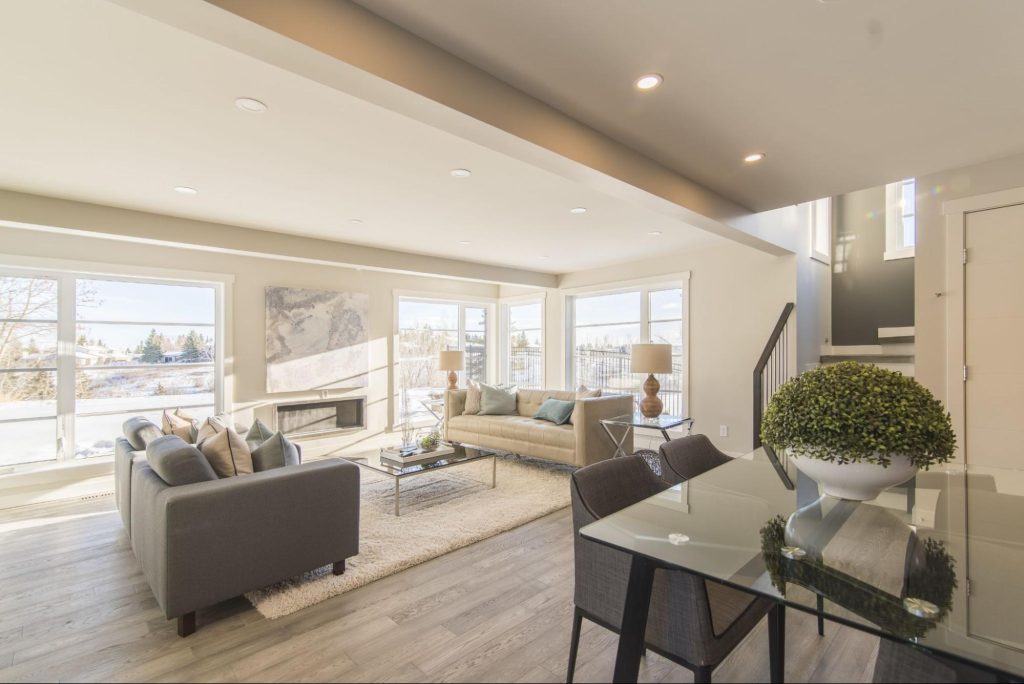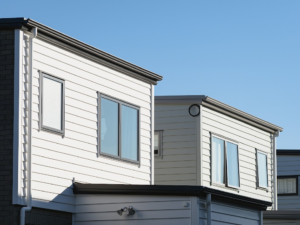The concept of open floor plan home designs has revolutionized modern living, offering a fresh and versatile approach to interior layout. Characterized by their spaciousness and seamless transitions between areas, these designs break down traditional barriers, promoting a more inclusive and interactive home environment. Whether you enjoy hosting gatherings, need a flexible space for your growing family, or appreciate the aesthetic appeal of an open layout, there are numerous benefits to adopting this modern approach. To better understand the concept of open floor plan, this article will highlight the key benefits of open floor plan home designs and explain why they are an excellent choice for contemporary living.
Ten Benefits of Open Floor Plan Home Designs
Open floor plan home designs have become a cornerstone of modern architecture, prized for their ability to create expansive, versatile living spaces. By removing traditional barriers, these designs foster a seamless flow between different home areas, offering a range of benefits that enhance both form and function. Here are the ten advantages of open floor plan home designs, showcasing why they have become a preferred choice for homeowners and architects alike.
1. Enhanced Natural Light
One of the advantages of open floor plans is the more natural light that floods the entire room. Without walls to block the light, windows, and skylights can illuminate larger areas, reducing the need for artificial lighting and creating a bright, welcoming atmosphere. This enhances the visual appeal while also promoting energy efficiency and general well-being.
2. Improved Social Interaction
Open floor plans are more than just a design choice, they foster a sense of community and togetherness. Ideal for families and those who love entertaining, these designs promote accessible communication and movement between spaces. Whether you’re hosting a dinner party or watching children while cooking, the lack of walls encourages social interaction, enhancing the overall living experience and fostering a sense of togetherness.
3. Greater Flexibility
With fewer walls to constrain the layout, open floor plans offer greater flexibility in how you use your space. However, it’s important to consider some design principles to ensure a functional and aesthetically pleasing layout. For example, consider the traffic flow and how different areas will be used. Furniture arrangements can be easily modified to suit different needs, whether you need a play area for children, a workspace, or additional seating for guests. This adaptability makes it easier to accommodate changing lifestyles and preferences over time.
4. Enhanced Flow and Movement
The seamless transition between spaces in an open floor plan facilitates better flow and movement throughout the home. This design can make even smaller homes feel more spacious and less cluttered, as there are fewer obstructions to impede movement. This ease of navigation can be particularly beneficial for individuals with mobility issues or young children.
5. Maximized Space Utilization
Open floor plans maximize available space by eliminating redundant areas such as hallways and corridors. This efficient use of space allows for larger living areas and can make homes feel more expansive and comfortable. The additional room can be utilized for larger furniture, creative decor, or additional storage solutions.
6. Aesthetic Appeal
An open floor plan’s clean, modern look is highly appealing to many homeowners. The uninterrupted sightlines and spacious feel contribute to a contemporary aesthetic that is both stylish and inviting. This design can be personalized with various decor styles, from minimalist to eclectic, enhancing the overall visual impact of the home.
7. Increased Property Value
Homes with open floor plans are often more desirable in the real estate market, potentially increasing their value. However, it’s important to consider the initial cost of creating an open floor plan, as it may involve removing walls or restructuring the space. Their modern appeal, enhanced functionality, and spacious feel attract prospective buyers, making them more competitive in the market. Investing in an open floor plan is a smart financial decision, but it’s important to weigh the potential return on investment against the initial cost.
8. Better Air Circulation
The open nature of this design promotes better air circulation throughout the home. Without walls to block airflow, heating and cooling systems can operate more efficiently, leading to more consistent temperatures and potentially lower energy bills. This improved circulation can also contribute to a healthier indoor environment, reducing the risk of mold or mildew.
9. Integration With Outdoor Spaces
Open floor plans often blend seamlessly with outdoor areas like patios, decks, or gardens. Large sliding doors or expansive windows can create a harmonious transition between indoor and outdoor living spaces, enhancing the overall experience and providing more opportunities for relaxation and entertainment.
10. Future-Proofing
Open floor plans are not just a trend, they’re a smart, future-proof choice. Their adaptability and flexibility mean that as your family dynamics or lifestyle needs change, your space can easily be reconfigured to meet new requirements. This long-term usability ensures that your home remains functional and relevant for years, giving you peace of mind about the longevity of your home design.
Open floor plans create inviting, functional, and adaptable living environments by maximizing space utilization, promoting better air circulation, and providing a modern aesthetic. These advantages make open floor plans an appealing choice for homeowners seeking to transform their living spaces into dynamic and cohesive areas catering to various lifestyles.
Are Open Floor Plan Home Designs Suitable for Any Lifestyle?
While open floor plan home designs offer numerous advantages, it’s important to consider whether they are suitable for your specific lifestyle. The appeal of expansive, connected spaces can vary depending on individual preferences, family dynamics, and daily routines. Below are the factors that determine the suitability of open floor plans for different lifestyles, helping you make an informed decision.
Families With Young Children
Open floor plans can be a great choice for families with young children. The lack of barriers allows parents to monitor their children from various parts of the home, making supervision easier. The flexible space can accommodate play areas, and the enhanced flow reduces the risk of accidents in tight or cluttered spaces. However, balancing the open space with designated areas for toys and activities is essential to maintaining organization.
Entertainers and Socialites
Open floor plans are ideal for those who love to entertain. The seamless connection between living, dining, and kitchen areas creates a spacious environment perfect for hosting gatherings. Guests can move freely and interact without feeling confined to separate rooms. This layout encourages a convivial atmosphere where social interaction thrives, making it a favorite among those who frequently host friends and family.
Professionals Working From Home
For professionals working from home, an open floor plan can offer benefits and challenges. The spaciousness and natural light create a pleasant working environment, and the flexibility allows for creating a dedicated workspace. However, it’s essential to ensure that the open space includes areas that can be used for quiet, focused work. Adding partitions or furniture to create defined work zones can help mitigate distractions and enhance productivity.
Multigenerational Households
Open floor plans can facilitate better interaction and shared living in multigenerational households. The design allows family members of different ages to spend time together while still having enough space to pursue individual activities. However, it’s crucial to consider privacy needs. Incorporating private nooks or separate areas within the open layout can balance communal and private spaces.
Privacy Considerations
While open floor plans offer many benefits, it’s important to consider potential challenges. They may not be ideal for those who prioritize privacy and quiet. The lack of walls means that noise can travel more efficiently, which might be disruptive in households with different schedules or noise sensitivities. Incorporating design elements like soundproofing, room dividers, or strategic furniture placement can help create quieter, more private areas within the open space. Additionally, maintaining organization and defining spaces can be a challenge in open floor plans, requiring careful planning and design.
Open floor plan home designs can be highly suitable for various lifestyles, offering flexibility, enhanced social interaction, and a modern aesthetic. However, it’s crucial to consider individual preferences, family dynamics, and daily routines to determine if this layout aligns with your needs. By thoughtfully assessing these factors, you can decide if an open floor plan is the right choice for your home.
How to Design an Open Floor Plan Home
Designing an open floor plan home involves more than just removing walls. It requires careful planning and creativity to ensure the space is functional and aesthetically pleasing. Every element is crucial in creating a harmonious and cohesive open floor plan, from selecting the right layout to choosing materials and decor. Here are simple steps for designing an open floor plan home.
Define Zones With Furniture and Decor
Defining different functional zones in an open floor plan is key to maintaining order and usability. Use furniture placement to create distinct living, dining, and cooking areas. Rugs, lighting fixtures, and decor can also help delineate spaces without walls. For example, a sofa can act as a divider between the living room and dining area, while different lighting styles can highlight various zones.
Maintain a Cohesive Design Theme
A cohesive design theme is crucial in an open floor plan to ensure the different areas blend seamlessly. Choose a consistent color palette, materials, and style for furniture and decor throughout the space. This uniformity creates a sense of unity and flow, making the open layout feel more intentional and harmonious. Mixing too many styles can result in a chaotic appearance, so it’s best to stick with a cohesive theme.
Optimize Lighting
Lighting plays a significant role in the success of an open floor plan design. Maximize natural light by incorporating large windows, skylights, or glass doors. Use a combination of ambient, task, and accent lighting to enhance functionality and highlight different areas. Floor lamps can warm the living area, while recessed lighting can be used above the kitchen island to provide general illumination.
Incorporate Storage Solutions
Effective storage solutions are essential to keep an open floor plan organized and clutter-free. Built-in cabinets, shelves, and multi-functional furniture can provide ample storage without disrupting the open feel. Consider using furniture with hidden storage compartments or incorporating storage into architectural features like kitchen islands or window seats. Keeping the space tidy and organized helps maintain the clean, open look that defines this design style.
Use Architectural Elements
Architectural elements such as columns, beams, and partial walls can add character and structure to an open floor plan without fully enclosing spaces. These features help define different areas while maintaining a sense of openness. For example, a half-wall or a row of columns can separate the kitchen from the living area, adding visual interest and subtle separation.
Designing an open floor plan home requires a thoughtful approach to creating a functional and visually appealing space. You can achieve a harmonious and efficient open layout by defining zones, maintaining a cohesive design theme, optimizing lighting, incorporating storage solutions, and using architectural elements. With careful planning and creativity, an open floor plan can transform your home into a modern, inviting living space.
Creating a Functional Open Floor Plan Home
An open floor plan home offers numerous benefits, but creating a functional layout requires strategic planning and design. Balancing openness with the need for defined, usable spaces is the challenge. This section explores key strategies for designing a functional open floor plan home that meets your practical needs while maintaining the spacious, airy feel that defines this design style.
Prioritize Traffic Flow
Ensuring smooth traffic flow is essential in an open floor plan. The layout should facilitate easy movement between different areas of the home without obstruction. Consider the natural pathways people will take from one zone to another and arrange furniture and decor accordingly. Avoid placing large pieces of furniture in the middle of walkways, and ensure ample space around key areas like the kitchen, dining, and living spaces.
Create Multi-Functional Spaces
One of the advantages of an open floor plan is the ability to create multi-functional spaces that can adapt to different needs. For example, a kitchen island can serve as a cooking prep area, a dining space, and a homework station. A living room can also function as a home office or a play area for children. Designing spaces with multiple uses in mind maximizes functionality and makes the most of the available space.
Incorporate Flexible Furniture
Flexible furniture options can enhance the functionality of an open floor plan. Consider using modular furniture that can be easily rearranged to suit different activities and occasions. Sofas, chairs, and tables with wheels or lightweight designs can be moved as needed, allowing you to reconfigure the space for gatherings, work, or relaxation. Foldable or extendable furniture can also provide additional functionality without occupying permanent space.
Ensure Adequate Privacy
While open floor plans promote interaction and connectivity, it’s important to incorporate elements that provide privacy when needed. Use room dividers, curtains, or sliding doors to create temporary private spaces. For instance, a retractable screen can separate a home office from the living area, or curtains can enclose a sleeping area in a studio apartment. These solutions offer flexibility and maintain an open feel while providing necessary privacy.
Focus on Acoustics
Managing acoustics is crucial in an open floor plan to prevent noise from becoming disruptive. Soft furnishings like rugs, curtains, and upholstered furniture absorb sound and reduce echo. Acoustic panels or soundproofing materials can also be added to walls and ceilings to improve sound quality. Designing with acoustics in mind ensures a more comfortable and enjoyable living environment.
Creating a functional open floor plan home involves thoughtful planning and design to balance openness with practicality. By prioritizing traffic flow, designing multi-functional spaces, incorporating flexible furniture, ensuring privacy, and focusing on acoustics, you can achieve a versatile and efficient layout. With these strategies, you can enjoy the benefits of an open floor plan while maintaining a functional and comfortable living space.
Unleashing the Potential of Open Floor Plan Home Designs
Open floor plan home designs offer many benefits, from enhanced natural light and improved social interaction to greater flexibility and increased property value. Unleashing the potential of open floor plan home designs transforms your living space into a versatile, inviting, and modern environment. This design approach maximizes space utilization and empowers you to adapt it to various lifestyles, making it a compelling choice for those looking to create a dynamic and cohesive home.
Visit the Build All Construction Inc. blog for expert insights, detailed guides, and inspiring projects.







